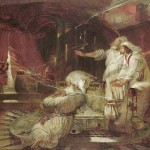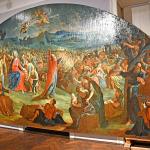
“He is not here.”
So were their words when I came upon the tomb and looked inside and beheld in the cave a woman at a wheel and all the world on that wheel. And as she spun it, some went to the top where there were riches and honour, and some to the bottom where there were misery and suffering. And behold, all the people were bickering and quarreling over whether any of them could move the wheel up or down by various degrees, and those at the top blamed those at the bottom until the wheel was turned again and it was the turn of those newly at the top to complain about those on the bottom.
Wherefore I asked them what was the point of all this and where was the end thereof for that they were all on the same wheel, but they could not answer straightly, for one said one thing, and one another, and it was always another person’s fault that the point had been obscured. And they went on like this, and I saw the innocent suffer and the guilty thrive, and I saw them all generally trampling each other as they went about the circle. And I could get nothing from them.
But then I noticed in the corner the folded clothes as of a man who had lain there, and I asked and said, “Where is this man, who was here, and is now not?” And they replied, “He has got up and gone out again,” and I asked, “Was he asleep?” and they answered, “No, dead.” And they went back to bickering.
And I pressed again and said, “What has he to do with you and your wheel and the purpose thereof,” and they said “Nothing whatsoever – so little was the space when his body was here, but now he has taken it away, by God. And there is now this vast space left where we can range at will and do as we please and the quarters are ours – such a lovely emptiness.” And I said, “But you are still bound to the wheel.” And they said, “Ah, but he is not here, such lovely emptiness.” And I said, “Might he not have something to do with your purpose and reason for continuing here?” and they said, “No, no, he cramps us.” And I looked into their eyes and saw they had absorbed the emptiness of that tomb and fed on it, and they looked at each other in love and said, “Such lovely emptiness,” and I looked and saw only horror, and they said, “He is not here.” And the emptiness yawned with a nausea of vanity, a wind uncanny in the twilight.
Of all the paradoxes of Christianity, one of the strangest is that the Good News should begin with the discovery of God’s absence, of a body we expected to find safely entombed that is in fact not. In narrative terms, this is like finding the bottom beyond the bottom, the fact that just when one thought things couldn’t go lower, they go in sideways, strange and confusing directions. Christ continues disruptive as ever – he will not even let us mourn properly and in peace, but has to be getting up again to unsettle things.
This fact, that the gospel begins with a proclamation of God’s absence – “He is not here” – is not something we have been keen to replicate in our evangelism, old or new. Part of this is for theological reasons, because our God is a God of presence, incarnation, before he is a God of absence. But part of it is due to fear, a fear that this is in fact the last word. The tomb – the world – is empty; the king has left the building; we dare not approach the matter because it might prove to be true. And so we shy away from the empty tomb.
Yet it seems to me that, without this profound emptiness, we do not have the Gospel. For the good news is precisely that – that though many of our experiences and encounters look into this emptiness – “Vanity of vanities,” says the teacher – the emptiness is not the last Word. There is another. But that Word does not take away the absence precisely. Rather, He draws us away from that absence. The absence is His footprint, marking where He has been. But it is as lonely as a footprint if we look to it for spiritual companionship.
Indeed, this is what I was trying to get at in the rather odd parable at the beginning of this post. Whereas some mythologies and religious systems suggest that life in the world is effectively parasitic on the body of a dead god (e. g. Norse mythology suggests our world is made from the bodyparts of the slain giant Ymir), it is I believe not unreasonable to assert that Christianity suggests we are squatters in the tomb of God crucified and risen, complete with all the ambiguity involved in that statement.
In this condition of course there are two ways we can go; we can seek as far as possible to drown our sensibilities in illusion, such that we numb our senses and feel the absence as little as possible (“How can they see with sequins in their eyes?” cf. Chicago), or we can follow the Ecclesiast in his terrifying tour de force iterating the vanity. Neither is really an answer – the latter is the serious tragedy of modernity and high modernism, the former the proclamation of postmodernity wherein death is swallowed up in glitter and sparkles. But in both, the absence remains.
Of course, the point of Christianity is that this absence is not all – there is an Elsewhere – if Christ is not here, it does not mean that he is not, but rather that there is a place other than here, a place where He is – He is risen. And the hope that we can find that Christ, that we can be Mary Magdalene distraught at his absence and talking to the gardener and suddenly realizing it’s Him, is precisely the hope we cling to, look for, and experience as Christians.
But the point I want to reiterate is that if we are to know this real hope, the emptiness of the tomb cannot be taken lightly, as though it were simply a distant and hypothetical technicality that is just as technically magicked away by God. One reason for this is that if we have not really seen the depth of the abyss, it is probable our refuge is in illusion rather than Christ – and, yes, illusion is often very happy to masquerade as belief in Christ; if things can be so easily papered over, all we have need of is a paper Christ, and we settle for such. But the other reason it matters is that there are those of us who find ourselves peering into the emptiness of the tomb daily and find the only way to survive it is to know that Christ is stronger – that “He is not here” can in fact be followed up with the more stubbornly hopeful phrase “He is risen!”
These last such people looking into the emptiness I empathize with particularly and keenly – being such a person myself – and it is for them in large part that I write. When we look around in the world and in the church; in the hearts of others and most especially in our own hearts; the first impression we get is very often emptiness. We are afflicted with corruption and decay; there is hypocrisy; good people suffer for no reason; bad people are successful; and even well intentioned people hurt others. Tug at one end of the string and the whole thing begins to unravel and the emptiness yawns beneath it, an abyss. And we see and are alarmed and peer into the darkness weeping and with despair cry, “He is not here!” – and such is the human condition. But as certainly the words boomerang back to us as though a liturgical response, “He is risen!” And we reply with sincerity, “Thanks be to God!”












